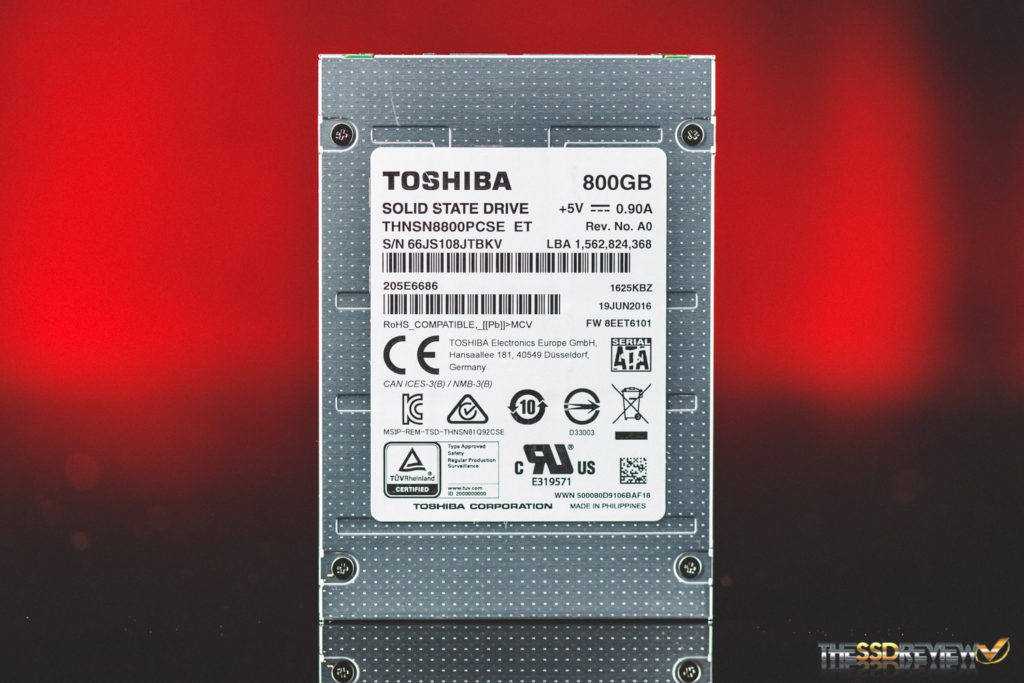What’s this? Another Toshiba HK4 series SSD review? Yes! This time around we are going to take a look at the higher endurance model of the HK4 family, the HK4E. The HK4E is rated for three drive writes per day rather than one like the HK4R. This does come at a cost though, the HK4E’s capacities are smaller due to over provisioning taking up 28% of the NAND, but at the same time it boasts improved random write performance. So, for those of you out there needing a mid-range SATA SSD for read oriented workloads, but also has some grunt to it to take database and VDI use, the HK4E just might be the SSD for you. Read on as we disassemble this bad boy and see how it performs in today’s review.
SPECIFICATIONS AND AVAILABILITY
The Toshiba HK4E is a SATA 6Gb/s 2.5″ 7mm SSD. It is currently available in capacities ranging from 200GB to 1.6TB. Sequential performance is rated for up to 525MB/s read and 503MB/s write while 4K random performance is rated for up to 75K IOPS read and 30K IOPS write.
Looking at its reliability ratings, the HK4E has an MTTF or Mean Time to Failure rating is 2 million hours and an AFR rating of 0.44%. Power consumption is rated for 4.5W active/1.2W idle, which is fairly average for a SATA SSD in its class. The operating temperature’s range is 0-55C and it is covered by a 5-year warranty. The HK4E’s endurance is rated higher than the HK4R at 3 DWPD, or up to 4380TBW for the 800GB model we are testing today.
| Toshiba HK4E | ||||
| Capacity | 200GB | 400GB | 800GB | 1600GB |
| Sequential Read (MB/s) | 524 | 524 | 524 | 524 |
| Sequential Write (MB/s) | 283 | 503 | 503 | 503 |
| 4K Random Read (IOPS) | 75K | 75K | 75K | 75K |
| 4K Random Write (IOPS) | 20K | 30K | 30K | 30K |
| Mixed IOPS (65/35 R/W, random 4K) | 35K | 50K | 50K | 50K |
| Endurance (DWPD)/TBW | 3/1095 | 3/2190 | 3/4380 | 3/8760 |
Taking a look at the enterprise class features, the HK4E is identical to the HK4R, nothing is missing. The HK4 Series SSDs are Toshiba’s first SATA SSDs with optional Trusted Computing Group (TCG) enterprise 3.0 encryption support. They also feature Toshiba’s proprietary QSBC (Quadruple Swing-By Code) error correction technology, which is their proprietary ECC to prevent data corruption caused by NAND flash memory wear, thus improving reliability and extending drive life. End-to-end data protection and PLP (power loss protection) is also included and guarantees data integrity during power loss. 28-bit LBA mode commands and 48-bit LBA mode commands are supported as well as NCQ. Finally, hot-plugging/OS-aware hot removal is supported.
A CLOSER LOOK
The HK4R comes in a standard 2.5mm 7mm form factor in a light alloy case and will weigh in at up to 60g max. Our 800GB review sample weighed in at 52g. It utilizes small thermal pads placed on each component package to help dissipate heat into the case and even cool the bottom of the PCB where there are no components.
Overall, we can see there are 8 NAND packages on a single side of the PCB. The NAND being utilized is Toshiba’s 15nm MLC, part number TH58TFT0EFLBA8H. Each package is 128GB in capacity and the SSD formats to 745GB within a Windows environment.
In addition, there is a single 1GB Micron DRAM package and a single large capacitor to provide for its power loss protection.
The controller is manufactured by Toshiba, part number TC58NC9K16GSB. This is the same controller used in the HK4R, so with this SSD the firmware is going to account for any differences in performance we see.
 The SSD Review The Worlds Dedicated SSD Education and Review Resource |
The SSD Review The Worlds Dedicated SSD Education and Review Resource | 

